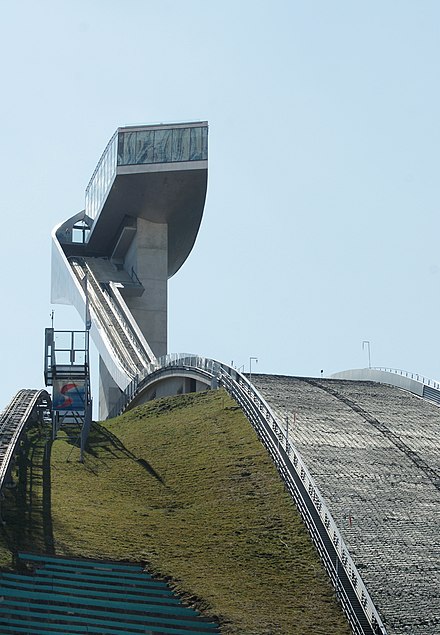Innsbruck - capital of the state of Tyrol, Austria
Innsbruck is the fifth-largest city in Austria and the provincial capital of Tyrol, as well as one of the largest cities in the Alps. It is in a valley of the river Inn between mountain ranges of above 2000 m above sea level, halfway between Bavaria and northern Italy, and is a hub of a region popular for skiing and other mountain-related activities and a busy tourist destination. Its popularity as a winter sports resort was underscored by its hosting the Winter Olympic Games twice.
Innsbruck offers the traveler an intriguing mix of contemporary and imperialist history, culture and architecture with a variety of architectural styles waiting to be discovered in every street.
Understand
The first mention of Innsbruck was during the reign of Augustus, when the Romans established the army station Veldidena (the name survives in today's urban district Wilten) at the locality named Oeni Pontum or Oeni Pons, which is Latin for bridge (pons) over the Inn (Oenus), the important crossing point over the Inn river, to protect Via Claudia Augusta, the economically important commercial road from Verona-Brenner-Augsburg.
Innsbruck became the capital of Tyrol in 1429 and in the 15th century the city became a centre of European politics and culture as emperor Maximilian I moved the imperial court to Innsbruck in the 1490s. Many old buildings from the Middle Ages and modern times survived in the heart of old town.
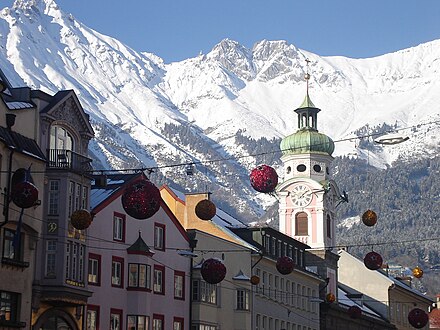
The city is well known for its sporting opportunities, especially alpine sports, as it is in the Alps and surrounded by mountains. Innsbruck also hosted the 1964 and 1974 Winter Olympics. Several ski resorts are situated inside the city territory or within short distance. Innsbruck was one of the centers of snowboard boom in the 1990s and the derived distinct subculture endured until today. The population of skateboarders, snowboarders and people alike is therefore above average and nothing unusual to the people. This culture is also celebrated by a lot of events in and around Innsbruck especially in the winter season, attracting (predominantly young) people from all around the world.
There are two universities and several colleges in Innsbruck, with over 30,000 students altogether, making the city's nightlife very lively.
Innsbruck has also become one of Austria's most eco-friendly cities, due to a very good public transport system and a partial ban on cars in certain areas of the historic old town.
Climate
Innsbruck's distance from the coast and altitude lead to a continental climate. Winters are cold and snowy; summers are generally warmer and wetter, with highly variable weather. Hot and dry days, with temperatures hitting 30°C, are quite common; but can be followed by a cool and rainy spell, with temperatures only around 17°C in the day. Summer nights are cool and temperature often drop quickly after sunset - sometimes falling below 10°C in early morning.
Get in
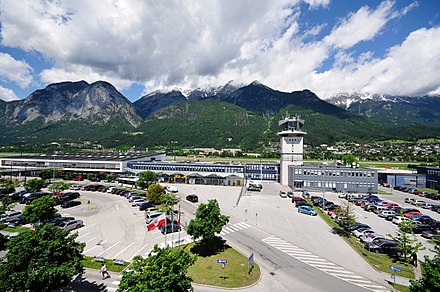
By plane
- Innsbruck Airport (Flughafen Innsbruck (IATA: INN), also known as Kranebitten Airport), 47.260278°, 11.343889°. The largest airport in Tyrol. Regular scheduled flights are available from:
- TUI fly Belgium 2x per week from Antwerp
- Austrian Airlines from Vienna and Frankfurt
- Transavia from Rotterdam and Amsterdam
- EasyJet from Berlin, London-Gatwick (also with British Airways) and 2x per week from Bristol
- Lufthansa from Frankfurt and Berlin-Tegel
- TUI Airways from London-Gatwick and Manchester
- Czech Airlines from Prague
- British Airways from London-Heathrow
- Sibir Airlines from St. Petersburg and Moscow
Seasonal flights (mostly active during skiing season) are available from many more destinations including the UK, the Netherlands, Greece, and Scandinavia, as well as from Berlin, Düsseldorf, Hamburg, Kyiv and Moscow. There are also charter flights to several German cities - especially in winter.
The bus line F will take you to the city center (every 15 minutes, on Sunday it departs every 30 minutes). A single ticket costs €3.10.
Other airports from which Innsbruck can be reached by train include Munich (IATA: MUC, 200 km), Memmingen (dead link: January 2023) (IATA: FMM, 175 km), Salzburg (IATA: SZG, 185 km), St. Gallen-Altenrhein (IATA: ACH, 190 km) and Friedrichshafen (IATA: FDH, 215 km).
By train
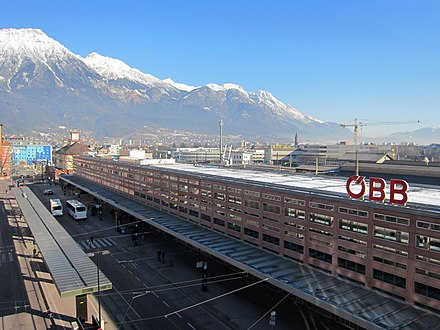 Regular direct trains run from Venice, Bolzano/Bozen, Zürich, Munich, Graz, Vienna (via Linz and Salzburg) and many other destinations.
Regular direct trains run from Venice, Bolzano/Bozen, Zürich, Munich, Graz, Vienna (via Linz and Salzburg) and many other destinations.
Austrian Nightjet sleeper trains run twice a week to Brussels, taking 15 hours via Munich, Cologne, Aachen and Liège, as well as to Amsterdam via Munich, Nuremberg, Hanover and Hamburg.
Despite being a smaller city, Innsbruck has fantastic train connections to all major cities in its region. The main station, Innsbruck Hauptbahnhof, is at Südtiroler Platz (South-tyrolean square) in the east of the city centre. There are several stations which serve suburban and regional train connections.
See Austria#Discounts for fare deals.
By bus
The bus station 📍 is right next to the main train station, and accommodates local, interregional and international traffic. There are connections to Seefeld, Wipptal, Ötztal, and Zillertal. International connections offer a budget friendly alternative for train travel, a one way ticket from Munich to Innsbruck with a stop in Garmisch-Partenkirchen costs ca. €11.
By car
Innsbruck is reachable through both of Tyrol's motorways: Inntalautobahn 📍 (A12) and Brennerautobahn 📍 (A13) which intersect in the south of Innsbruck.
During holiday seasons, when Europeans either try to get in or out of Italy over the Brenner Pass 📍 in summer or try to reach or return from ski resorts in winter, heavy traffic should be expected on both motorways particularly during weekends. Snowfall inevitably makes the traffic situation worse, so it is recommended to tune in to Radio Tyrol at 96.4 MHz FM for the latest traffic updates.
By bike
Innsbruck can be reached on the Inntalradweg from Passau to St. Moritz. Even in the city this bicycle trail is signposted with small green road signs.
Get around
Most one-day visitors don't use any transport: all of the major Old Town sites are within a reasonable walking time.
On foot
The classic walk into old Innsbruck follows.
From the main station (Hauptbahnhof) to the city center is a relatively short and enjoyable 10 to 15 minute walk. Walk out of the Hauptbahnhof, cross the street at the train station cross walk, turn to your right, and go down to the next street to your left. Walk on this street until Maria-Theresien Strasse, then turn right toward the city center. Taking this street all the way leads to the pedestrian zone and the Golden Roof.
By car
Big parts of the downtown area are declared (fee-based) short-term parking zones. For longer visits, it is highly recommended to park off-site and use public transportation.
By public transport
Public local traffic (6 tram-lines, and a dense network of buses) is operated by Innsbrucker Verkehrsbetriebe and a couple of private operators. All public services are organized in Verkehrsverbund Tirol, which means that tickets are valid in every public transport line (including buses, trams and trains). All buses and trams are modern low-floor vehicles.
Sometimes bus lines are split up into different destinations and so it's important to pay attention to the destination displays (outside and inside) and the spoken announcements. Single-fare tickets are €3 in the city fare zone if paid by the driver or €2.40 if purchased at ticket machines. 5-trip tickets are available for €8.00 or €10.00, respectively. Regardless of the door you enter, go to the driver and pay, exact change not necessary. daily tickets, weekly tickets and other sorts of tickets are only offered at multi-language ticket machines to be found at many stations. They can also be purchased at the identically looking machines for short-term parking tickets. You must validate the ticket when you get on your first bus or tram. See the website for all available tickets.
The special bus line "TS" ("The Sightseer") connects the major sights like Schloß Ambras, Bergisel and Alpenzoo to downtown. However special fares apply for this line. If you don't plan to visit every museum it might be reasonably cheaper to use the normal 24 hour ticket without this bus.
Two tram lines lead to two villages in the neighbourhood of Innsbruck.
Tram line nr. 6 connects Innsbruck and the mountain village Igls, which is worth a visit. The line passes the uplands with vast forests and gives some spectacular prospects for travellers either on Innsbruck or on the lovely landscape between Aldrans and Igls. It provides stops immediately near Schloß Ambras and the bathing-lake Lansersee (ice skating in Winter is also possible there). The terminus Igls lies within the city fare zone, so no additional ticket is needed.
Tram line STB is 18 km long and connects Innsbruck with several villages in the Stubaital valley. This tram provides also access to Bergisel (Tirol Panorama) at the station Sonneburgerhof. This station is also situated within die city fare zone. In Mutters, Nockhofweg access to an easy skiing area, the Mutteralm, is provided (10 minutes walk). A beautiful hour's ride will take you at least the small town of Fulpmes. The new red liveried trams offer great scenic views on the journey. It is recommended to make a trip around Halloween, when the larch-trees on the Telfer Wiesen have got their best autumn colour.
By S-Bahn
A suburban train system called S-Bahn with five routes (S1 - S5) connects Innsbruck to villages and towns around the city, from Landeck to Kufstein or Kitzbühel and from Mittenwald to Brenner. Timetables and fares can be found on the VVT website. Inner city VVT tickets are valid between the Hauptbahnhof and Westbahnhof 📍 (west station), Hötting 📍, Allerheiligenhöfe 📍, and Kranebitten 📍.
By bike
Cycling is common in Innsbruck and especially popular among students. Innsbruck has some bicycle paths, but they are not very well interlinked within the city. A map of all bicycle ways/lanes is available here. In 2012, Innsbruck was awarded Fahrradhauptstadt (cycling capital) by VCÖ (an Austrian traffic advocacy group).
Innsbruck offers short-term shared bike system Stadtrad. It is subject to compulsory registration via this page (dead link: January 2023) or machines standing next to the bikes, and requires a credit card number. The registration costs €1 and yields a credit of €1 on the account. A ride less than 30 minutes costs €1, less than 1 hour €3, for every additional hour €3, up to a total of €15 for 24 hours (see their fare overview (dead link: January 2023)). The locations are displayed on a map on this site (dead link: January 2023). If you plan on using the bike frequently, you may consider getting an annual membership for €25, which reduces the cost of rentals substantially.
See
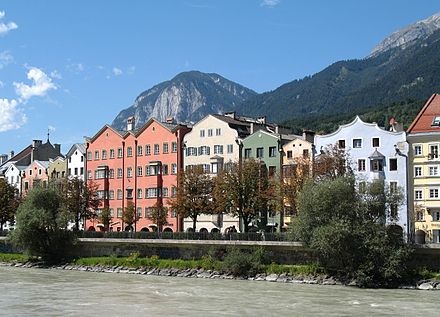
The Innsbruck-Card (dead link: January 2023) offers free entrance to all of Innsbruck's sights, free use of public transportation (including the TS line). It also includes a one-time ascent&descent to Nordkette, Patscherkofel and Axamer Lizum, and a 10% discount to Swarovski Crystal Worlds in nearby Wattens. The Innsbruck-Card is valid for 24/48/72 hours and can be purchased at Innsbruck Information (Burggraben 3), the TI in Hauptbahnhof, and several museums and tourist offices. The latest Innsbruck card fare can be found here (dead link: January 2023). Since 1 May 2018, rates are €43/€50/€59 for 1/2/3 day cards for adults, and €21.50/€25/€29.50 for children 6-15 years old. And daily or weekly public transport cards are cheap - the "all inclusive" sales pitch is alluring to disoriented travellers, but make sure the discounts are worth the initial price. If you are not seeing these major entrance-fee sites, remember that you may buy more than one daily card at a time, as the 24 hours only starts once validated. Be sure to compare with the price of a weekly ticket too.
The bus line Sightseer (TS) connects the major sights in Innsbruck. However, there is always a cheaper public transport line going to the same destination, though it might take you more time.
Churches and cathedrals
-
Hofkirche, Universitätsstraße 2, 47.2682041°, 11.39528°. Innsbruck's Hofkirche has the most important emperor's tomb monument (of emperor Maximilian I) in Europe. Especially characteristic are the larger-than-life bronzes ("schwarze Mander") that show members of different dynasties. Entrance: €3, reduced: €1.50, free with the Innsbruck-Card
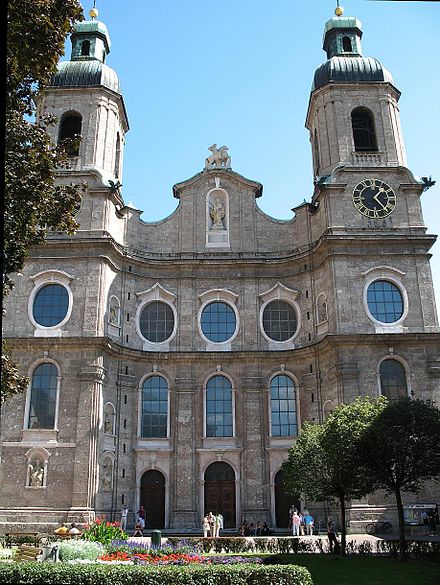
-
Cathedral at Saint Jacob (Dom zu St. Jakob), Domplatz, 47.2693674°, 11.3941432°. Baroque styled cathedral, with works of Lucas Cranach the Elder. From 1717-1724 it was rebuilt (after damage from an earthquake) according to the plans of Johann Jakob Herkomer and Johann Georg Fischer. Free entrance
-
Wiltener Basilika, Haymongasse/Pastorstraße, 47.2541137°, 11.3983263°. Baroque styled church with Rokkoko-stucco, built from 1751-1756. Free entrance
-
Stift Wilten, Klostergasse, 47.2537234°, 11.4004438°. Premonstratensian monastery with a baroque collegiate church, not far from Wiltener Basilika. Free entrance
Castles and palaces
- Ambras Castle (Schloss Ambras), Schloßstraße 20 ( or ), 47.2557546°, 11.4340332°, +43 1 525 24 4802, info@schlossambras-innsbruck.at. 10:00-17:00. A castle and palace in Renaissance style that was built in 1563 on behalf of Archduke Ferdinand II of Tyrol in the hills overlooking the city, at an elevation of 587 m above sea level, and served as his private residence from 1563 until his death in 1595. It is widely considered one of the most important Renaissance era buildings of its time in Tyrol, and now among its top tourist attractions. Supplanting an earlier 10th century fortification, the castle became the seat of power for the Counts of Andechs. Hosting Ferdinand's art collection, the castle is considered the oldest museum in the world. Interesting things to see are portrait- and armour collections, art and curiosity cabinets. The Lower Castle is home to armouries featuring numerous masterpieces preserved as evidence of the armourer's art from that era. Only the Renaissance era work has been reserved at its original location, making the Chamber of Art and Curiosities an unrivaled cultural monument. The Spanish Hall will be one of the highlights of any visit, located above the Lower Castle and decorated with a wood-inlay ceiling and walls adorned with 27 portraits of historic Tyrol royals. It remains one of the best examples of German Renaissance architecture. As one of Innsbruck's most popular attractions, waiting lines at the entrance are often long. Try to arrive a bit before it opens at 10:00 to stay ahead of the crowds. April to October: €10. December to March: €7 2018-09-22
Buildings
- Bergiselschanze (Ski jump), Bergiselweg 3 ( or ), 47.2466656°, 11.3992785°. Daily 09:00-18:00. The Bergisel jump is a design by Iraq architect Zaha Hadid in 2001, replacing the far less glorious jump stadium that hosted the 1964 and 1976 Winter Olympic Games. You can still stand beneath the Olympic rings and flame holder, and either walk 450 steps to the top or take a funicular lift. Because of its design and prominent location (on Bergisel, south of Innsbruck) it is considered a new city landmark. During sporting events, the jumping tower is not accessible, and a ticket is needed to enter the terrain. 2018-09-19
- Bergisel Sky Panorama Café, Bergiselweg 3, 47.24675°, 11.39974°. Daily 09:00-18:00. Café on top of the ski jump, with a great view over Innsbruck and the surrounding mountains. They have good Apfelstrudel (apple cake). 2018-09-19
- Helbling House (Helblinghaus), Herzog-Friedrich-Strasse 10 ( or ), 47.2684°, 11.3932°. A 15th-century house which adopted different architectural styles in later centuries until it evolved into its current amalgamation of Gothic and Baroque facade. The Rococo stucco decorations that look like icing on a cake were added in the early 18th century, and these bows, window frames, oriels, masks, sculptures and shells are what makes this building unique. The architecture helps to capture a maximum of sunlight, which is sparse in the Alps. The last major construction took place in 1732 by Anton Gigl, after which the building was renamed to Sebastian Helbling who owned it at from 1800 until 1827. 2018-09-20
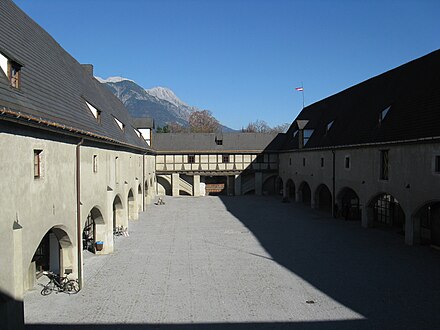
- Armoury (Zeughaus), 47.27077°, 11.40749°. Construction of the Armoury between 1500 and 1505 was ordered by Maximilian I to strengthen the defensive capabilities of the city, as illustrated by its location near the city walls at the time, next to the main entrance gate of the Sill. The building consists of 2 large 80 m long wings and 2 narrow gatehouses forming a large inner courtyard. It served as a storage for weapons such as cannons and small arms, and a training ground for the city guard. The Armoury retained its function as barracks until the fall of the Austrian Empire in 1918, after which it was closed. The Tyrolean State sourced funds for an extensive restoration from 1964 until 1969, and the Armoury reopened for the public in 1973 as the Tyrolean State History Museum, a branch of the Tyrolean State Museum. On display are historical and technical collections illustrating the history of Tyrol from classic antiquity to the present. In summer, the inner courtyard is often use for open-air cinemas and concerts. 2019-01-11
Memorials

- St. Anna Column (Annasäule), Maria-Theresien-Straße, 47.2656733°, 11.3941983°. 24/7. The column, which is made of Tyrolean marble, was created in 1706, in memory of the withdrawal of Bavarian troops. Free 2018-12-21
- Triumphal Arch (Triumphpforte), Maria-Theresien-Straße (Southern end of Maria-Theresien-Straße), 47.262591°, 11.394785°. 24/7. It was built in 1765 to mark the marriage of archduke Leopold and the Spanish princess Maria Ludovica. The north side displays mourning themes on the occasion of Franz Stephan of Lothringen. Free
Museums
A combined ticket for the Tyrolean State Museums (dead link: January 2023) is available for €10, or €6 discount, and offers entry to The Ferdinand, Hofkirche, Volkskunst, Zeughaus and Das Tiroler Panorama Museums until the end of the calendar year. The ticket includes a free audio guide (which is worth getting as information is otherwise only in German) at some locations.
- Alpinist Association Museum, Wilhelm-Greil-Straße, 47.2689°, 11.3949°, +43 512 587186 12, bergeleidenschaft@alpenverein.at. Daily 09:00-17:00. Museum dedicated to the history of alpinism, hosted in the Hofburg. The museum is owned and operated by the Austrian Alpine Club ÖAV, and received numerous prizes including the Tyrolean and Austrian Museum Prizes, as well as being nominated for the European Museum Prize in 2010. The original museum opened in 1911 in a former villa on the Isar river side, but was destroyed by shelling in 1944 during the Second World War. It was rebuilt and reopened in 1977 in its current location. Since 1996 there are regular exhibitions on various mountaineering related topics. The collection covers over 700 m² of exhibits. €1.10-5.50; free with Innsbruck Card 2018-09-17
- Anatomical Museum (Anatomisches Museum Innsbruck), Müllerstraße 59, 47.2606705°, 11.3875467°, +43 512 9003 71111, romed.hoermann@i-med.ac.at. Th 15:30-18:00, closed on holidays. From June to September only on appointment. Famous for its exhibition Body Worlds, the modern version of an anatomical museum. It belongs to the city's university, hosted in the Institute of Anatomy. On display are numerous human specimens, skeletons, skulls, and other models. In addition, there are jars with dissected organs (lungs, hearts, ...) and other wet and dry samples. A visit to the museum gives insight in the history of anatomy, and the development of anatomical devices. Visitors should be aware that real people and body parts are on display, so a visit may not be suitable to young children. 2018-12-22

- Graßmayr Bell Museum (Glockengießerei Grassmayr), Leopoldstraße 53 (tram lines 1, 3 and TS), 47.256286°, 11.398137°, +43 512 5941637, info@grassmayr.at. M-F 10:00-16:00; May–October also Sa 10:00-16:00. The Bell foundry has existed for 400 years, and been lead by the same Graßmayr family for 14 generations. The museum offers visitors the unique experience of feeling the craftsmanship involved with generations of bell making traditions. The museum was awarded with many prizes such as the Austrian Museum Prize and the Maecenas Prize. Adults €8, children €5 2018-12-21
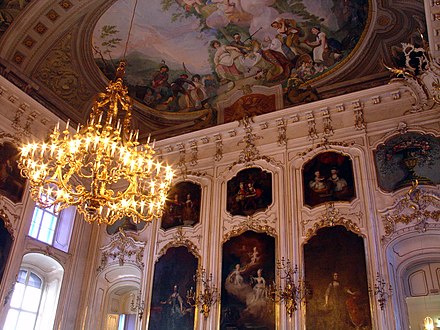
- Imperial Palace (Hofburg), Rennweg, 47.2688635°, 11.3948986°. Daily 09:00-17:00. The palace is a former Habsburg palace, and considered one of the 3 most important cultural buildings in Austria (the others being the Hofburg palace and Schönbrun palace in Vienna). It is the main building of a large residential complex used by the Habsburg dynasty. Construction started around 1460 under Archduke Sigismund, including medieval fortifications such as the Rumer Gate which was converted into the Heraldic Tower in 1499 under Emperor Maximilian I. The palace saw numerous expansions during the next 2.5 centuries. The most significant alterations were made between 1754 and 1773 under Empress Maria Theresia, who gave it a Baroque outlook. The palace now hosts 5 themed museum areas: Maria Theresia's Rooms from the 18th century, Empress Elisabeth's Apartment from the 19th century, a Furniture Museum, an Ancestral Gallery, and a Painting Gallery. The museum areas illustrate different aspects of the political and cultural history of the imperial palace under reign of the Habsburg dynasty for over 4.5 centuries. 2018-12-22
- Tyrol Panorama Museum (Das Tirol Panorama), Bergisel 1 (S-Bahn 1 to the Bergisel stop), 47.2503801°, 11.4016461°, +43 512 594 89, info@tiroler-landesmuseen.at. W-M 09:00-17:00. With construction finished in 2010 for €25 million, the museum's only attraction is the Giant Panoramic Painting, which was transferred to the building in September of the same year. The painting depicts the Tyrolean Rebellion of 1809 on 1,000 m² of canvas, a battle in which the Tyrolean people fought against the invading Bavaria army. A free audio commentary takes visitors into the heart of the battle. Adults €8, students and elderly €6, children free 2018-09-19
- Imperial Hunters Museum (Kaiserjägermuseum), Bergisel 1-2, 47.2510307°, 11.4011413°, +43 512 59489610. W-M 09:00-17:00. A small museum dedicated to the Kaiserjägern (Imperial Hunters), Emperor Franz Joseph I's battalion of guards. The name Jäger, "hunter" in German, is a reference to light infantry. The museum opened in 1878 and was maintained by the Jägers themselves under regiment commander Oberst Knöpfler. The collection features memorabilia, weapons, uniforms, photographs and personal belongings of former Jägers. The garden of the museum hosts the Tomb of the Unknown Soldier, dedicated to the 20,000 Jägers who died during the First World War. The Jäger battalions were disbanded in 1918 when the Austrian Empire dissolved, but the museum was preserved. The museum was hit by a bomb during the Second World War but rebuilt in 1959 and expanded with a chapel and 2 rooms with display cases containing the 154 books in which the names of fallen Tyrolean soldiers are recorded. Adults €8, students and seniors €6, children free 2018-09-17
- Maximilianeum, Herzog-Friedrich-Straße 15, 47.26865°, 11.39326°, +43 512 581111. Tu-Su 10:00-17:00. Museum dedicated to Emperor Maximilian I and his wife, their significance to Tyrol and Austria, and the living conditions of the early 16th century. 2018-09-17
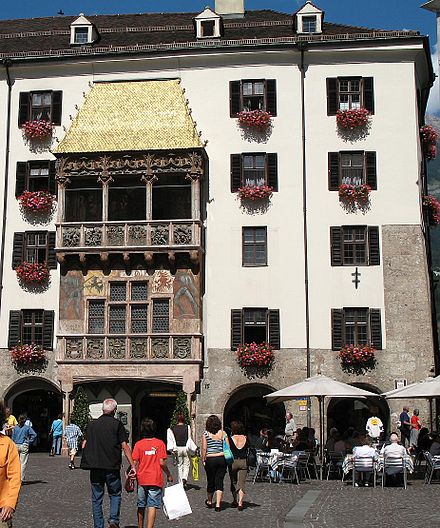
- Golden Roof (Goldenes Dachl), Herzog-Friedrich-Straße 15, 47.2686°, 11.3933°. 24/7. Most famous landmark of the city since 1500, the Golden Roof is a late-Gothic alcove balcony of which the roof is decorated with 2657 fire-gilded copper tiles. It was built to commemorate the wedding of Emperor Maximilian I with Bianca Maria Sforza. The balcony allowed the Emperor and his wife to enjoy festivals, tournaments and other events on the square below. Free 2018-09-19
: Jakob Hutter, founder of the Hutterite sect, was burnt at the stake in this square in 1536.
- City Tower (Stadtturm), Herzog-Friedrich-Straße 21, 47.268224°, 11.3934904°. Historic city tower, reaching 51 m height, and visitors can climb the 148 steps for a fee to reach the viewing platform at 31 m which rewards for the effort with a view over the historic city (Altstadt). It is a Gothic tower with a quadrangular substructure and consists of 6 floors. Above the viewing platform sits a narrower octagonal structure with 4 semicircular bay windows and a large dome roof. It was constructed between 1442 and 1450 at the old town hall to reflect the increased self-confidence of Innsbruckers in their defensive capabilities, with watchmen manning the tower day and night. The first documented tower guard took service in 1529 by order of the city council, and warned the townspeople in times of fire, assaults, or other dangers. The room at the ground floor has been used for watchmen meetings as late as 1951. During the Middle Ages, the lower area of the tower also served as city prison, and the barred windows on the first 2 floors are remnants of that function. The original Gothic tower was renovated, enhanced and rebuilt several times. Most notably in 1586, 4 wrought-iron gargoyles were added as decorations. The clock was added in 1603 by Erasmus Melchior. €4 2019-01-08
- Tiroler Landesmuseum, 47.2673275°, 11.3977336°. Ferdinandeum, Museumstraße, Scientific collection, Feldstraße and Museum im Zeughaus, Zeughausgasse
- Folk Art Museum (Tiroler Volkskunstmuseum), Universitätsstraße 2, 47.2686°, 11.3956°, +43 512 59489 510, volkskunstmuseum@tiroler-landesmuseen.at. Daily 09:00-17:00. Considered among the finest regional heritage museums in Europe, next to the Hofkirche and across from the Hofburg. Its collection features a remarkable selection of cultural artifacts from Tyrol, spread over four wings of a former Franciscan monastery around an arcaded Renaissance courtyard. The permanent exhibition includes handicrafts, costumes, household items, glass, pottery and ceramics, furniture, and many more. A large part is devoted to religious and secular folk art. The architecture of the museum itself is also worth visiting, with rooms outfitted in wood-paneled Gothic, Renaissance, and Baroque style salvaged from noble houses in the area. 2018-09-17
- Small Cable Railway Museum (Seilbahnmuseum), Höhenstrasse 145, Hungerburg (in the base station of the Seegrubenbahn), 47.28608°, 11.39913°, +43 512 293344, info@nordkette.com. Daily 08:30-17:30. A small museum dedicated to the history of cable railways, focusing mainly on the history of the Nordkette Cable Railways. Set up in a former classroom, the museum has an authentic replica on display of the very first cable car that made the journey to the top of the Nordkette mountain. Its collection features many pictures and artifacts detailing the past and present technology involved in the construction of alpine transportation systems. Free 2018-09-19
Parks
- Botanical Garden (Botanischer Garten), Sternwartesstraße 15 (Bus A will take you just outside of the main entrance), 47.2678521°, 11.3797808°, +43 512 507 5910, Botanischer-Garten@uibk.ac.at. Daily 07:30-19:00. In the winter, the garden is open until 16:30. The garden is operated by the University of Innsbruck and covers an area of 2 ha. It was established around 1911 and replaced an earlier garden, then redesigned after the Second World War from 1948 to 1965. The Alpine rock garden underwent another revision from 1987 to 1990 to update it to the most modern botanical principles. The greenhouses were constructed in 1909, with 3 additional greenhouses added from 1977 to 1979, a succulent house in 1993, and a 6th greenhouse for container plants in 1997. Visitors can view over 5,000 different species in the garden. Free, for greenhouses Adults: €2, Children, students, and seniors: €1 2019-01-08
- Hofgarten (Imperial Palace Park), Two minutes away from the Old Town (entrances at Rennweg and Kaiserjägerstraße), 47.27153°, 11.39719°, +43 1 813 59 50, office@bundesgaerten.at. 24/7. Large park at the edge of the Old Town (Altstadt) covering an area of 10 ha between the Congress Palace, the Imperial Palace (Hofburg) and the Tyrolean State Theatre. The initiative for the park was taken by Archduke Ferdinand II in the 16th century, and at the time of completion it was one of the most elaborate gardens north of the Alps. It underwent transformations into a Renaissance style garden, a French formal garden, and since 1858 an English landscape garden. The garden features ponds, a playground, a palm house with 1700 species, and several restaurants and bars. Some of the plants in the park were planted by Austrian empress Maria Theresa. Free
- Alpenzoo, Weiherburggasse 37 (accessible using the Hungerburgbahn - short footway - or by bus, line TS), 47.2817256°, 11.3977263°, +43 512 292323, office@alpenzoo.at. 09:00 - 18:00 daily in summer, 09:00-17:00 daily in winter. The alpine zoo is Europe's highest situated zoo (727 m), and is specializing in alpine animals, with 2.000 animals of 150 species on display. It contains outdoor enclosures, terrariums, aviaries, aquariums (world's biggest collection of alpine fish species) and a barnyard with old farm animal races. The zoo is in hillside situation, so there's a certain altitude difference to cover. Founded in 1962 by Austrian zoologist Hans Psenner, the Alpenzoo is a non profit initiative aimed at conservation of Alpine animals, and is praised for its efforts to reintroduce endangered species like the bearded vulture, Alpine ibex and northern bald ibis in the wild. Free entrance with the Innsbruck-Card. Adults €11, students €9, children €5.50 2019-01-07
Do
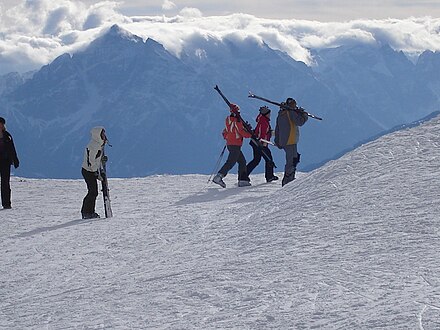
Winter sports
There are a lot of ski resorts in the mountains surrounding Innsbruck, many of which offer free ski buses from the city center so long as you have ski gear and/or a valid ski pass, making it a great place to base one's self. Discount or combo passes can reduce the costs of skiing or snowboarding. In 2022-2023, a "SKI plus CITY pass" combines winter sports discounts with city sightseeing passes.

Below is an overview of notable ski areas easily accessible from Innsbruck. For full information about resorts around Innsbruck and Tirol, see Bergfex.com.
{| class="wikitable" !Name||Tel.||Altitude||
/
/
||
/
/
|- |Seegrube – Nordkette|| +43 512 29 33 44 ||860 - 2.260m||4 Lifts: 2 / 2 / -|| 14 km Pistes: 1 / 8 / 5 |- |Igls – Patscherkofel|| +43 512 377234 ||900 - 1.960m||8 Lifts: 1 / 2 / 5|| 18 km Pistes: 10 / 8 / - |- |Axamer - Lizum|| +43 5234 68240 (Kasse)||1.583 - 2.340m||10 Lifts: 1 / 6 / 3|| 41 km Pistes: 4 / 27 / 10 |- |Kühtai (dead link: October 2017)|| +43 5239 5222||2.020 - 2.520m||11 Lifts: 1 / 4 / 6|| 44 km Pistes: 7 / 29 / 8 |- |Schlick-2000|| +43 5225 62270|| 1.000 - 2.230m|| 10 Lifts: 2 / 1 / 7|| 25 km Pistes: 18 / 8 / 1 |}
- Nordpark (dead link: January 2023) is accessible via the tram line 1, the bus lines 1, 4, A, D, E, J and T. The Nordkettenbahn goes up to Seegrube and Hafelekar, where many hiking routes and trip routes start. The Nordpark Singletrail is one of the most ambitious mountain bike freeride routes of Europe.
In winter, the Nordpark can offer several ski routes. They are steep and offer a great view of the nearby mountains and the city itself. One ascent&descent is free with the Innsbruck-Card. It is possible to walk or hike all the way up to the summit without taking the cable cars. It is vigorous but doesn't require special equipment. There are places where it is not completely clear which way to go (even with local hiking).
- Patscherkofelbahn. Accessible via bus line J, destination "Patscherkofelbahn" or "Olympiaexpreß" and tram line 6 to Igls. Tram line 6 is particularly worth taking - a beautiful meandering route up the mountain and included in the city zone of Innsbruck's public transport. Much better value than the Hungerburgbahn on the Nordkette. The Patscherkofel is a skiing region south of Innsbruck, that has a number of timbered ski-runs of the former olympia-routes. In summer it is a great region for hiking along the forestline.
One ascent&descent is free with the Innsbruck-Card.
- Axamer Lizum, 47.19566°, 11.303208°. Large ski resort with a a variety of challenging terrain and runs. Lots of terrain for off piste skiing or snowboarding. Hosted several downhill skiing events in the 1964 and 1976 Winter Olympics. Easily accessible from Innsbruck using the free ski bus (picks up at Innsbruck Hauptbahnof). 49 euros adult (high season) (December 2022)
- Stubaital](http://www.stubai.at/). Offers several ski resorts in the winter.
Ice skating is a popular winter activity and there are several public outdoor rinks with evening hours and rental skates (ask for directions to the nearest eislaufplatz). Olympiaworld has an outdoor rink and its TIGLS Arena is used for ice hockey.
It's a bit safer and tamer than bobsledding, but it's still plenty fast and exciting...it's called Bobrafting and you can do it on the Olympic bobsled run in Igls.
Games
The Alpine weather can be unpredictable, and with rain likely to fall in every season, having indoor alternatives to outdoor activities is a must when visiting Innsbruck. For those who enjoy puzzles and riddles, there are 11 room escape games to play in the city.
- Escape Game Innsbruck, Tschamlerstraße 3, 47.2578229°, 11.3961853°, +43 512 552461, info@escapegame-innsbruck.at. M-Th 10:00-20:30, F-Su 10:00-22:30. Indoor room escape type games, with 5 different scenarios. Each scenario takes 1 hour to complete. 2018-12-21
- The Art of Stealing (Die Kunst des Klauens): Players take the role of art thieves, and must steal artworks from a villa before the owner returns. For 2-6 players, entry level difficulty, from 10 years old.
- The Sorcerer (Der Zauberer): Race against time in search for a Life Elixir in the laboratory of a sorcerer. For 2-6 experienced players, from 10 years old.
- The Orphanage (Das verlassene Waisenhaus): Players find themselves trapped in an abandoned orphanage where nothing is what it seems to be. For 2-6 players. Contains horror elements, 14 or older recommended. Medium difficulty level.
- The Haunted Mansion (Das Geisterhaus): In the role of real estate agents, players find themselves trapped in a haunted mansion. For 2-6 players, medium difficulty level. Scary elements, 12 or older recommended.
- The Wrath of Tutankhamen (Die Rache des Tutanchamun): Players take the role of grave robbers, getting lost in Tutankhamen's tomb, with only 60 minutes of oxygen to breathe. For 2-6 experienced players, from 10 years old.
- Room Escape PerplexxX, Bettelwurfstraße 2 (Bus 504, get off at , 2 min. walk), 47.275803°, 11.4391468°, +43 677 61441095, office@perplexxx.at. W-F 16:00-22:00, Sa Su 13:00-22:00. Indoor room escape type games with 3 scenarios. Each scenario takes 1 hour to complete. 2018-12-22
- The Golden Roof (Das Goldenes Dachl): Players find themselves in the year 1976, exactly an hour before the start of the Winter Olympic Games, when it is discovered that a single tile from Innsbruck's famous Golden Roof has been stolen. Players need to unravel clues and decipher puzzles to find the missing tile before the opening ceremony starts! Easy difficulty level.
- Phobia: Players must unravel the mysteries surrounding an inhabitant of Innsbruck, breaking into his house with only 60 minutes before his return. A game with an unexpected ending! Medium difficulty level.
- The Big Heist (Der grosse Coup): Players break into the Ferdinandeum, Innsbruck's Art Museum, and have only 1 hour to get out with a priceless piece of art. Advanced difficulty level.
- Riddle Room (Rätselraum Tirol), Leopoldstraße 31, 47.2593634°, 11.3973241°, +43 677 61851232, info@raetselraum.at. M Th Su 14:00-22:00, F Sa 14:00-midnight. New room escape game in the city centre. In the scenario of Dr. Healers Secret Laboratory, one of the players has contracted a mysterious disease after being bitten by a rodent in the Tyrolean Alps. The team must find a cure within 60 minutes, using the secrets at their disposal in Dr. Healer's laboratory. For 2-6 players, game can be played in English or German. €60 for 2 players, €75 for 3 players, €90 for 4 players, €100 for 5 players, €108 for 6 players 2018-12-22
- Play The Game, Josef-Wilberger-Straße 9, 47.277591°, 11.433499°, +43 650 2029199, playthegame.escape@gmail.com. Indoor room escape games, with 2 different scenarios. Play time: 1hr 15min. Both games are for 2-6 players from 14 years old. 2 players €59, 3 players €79, 4 players €86, 5 players €89, 6 players €99. 2018-12-22
- Temple Run: Players find the Philosopher's Stone from the Mayas, and venture into the jungle searching for the ancient gold treasure. On the way, adventure awaits, with many puzzles and riddles to solve. Medium difficulty level.
- Secret Agent: As secret agents, players are tasked by the president to recover a suitcase with state secrets in a race against time. Hard difficulty level.
For those who prefer to gamble in a more glamorous environment, the casino offers an entirely different type of entertainment for adults, read more via this page in a useful review about Austrian best casinos.
- Casino Innsbruck, Salurner Straße 15, 47.2622906°, 11.3963225°, +43 512 587040. 10:00-03:00 daily. Tyrol's largest adult gaming and gambling centre.
Nordkettenbahnen
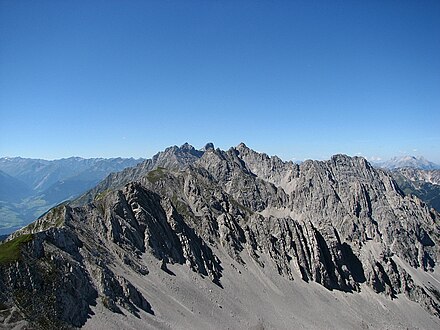 The Nordkettenbahnen are 3 alpine vehicles bringing visitors from the historic centre of the city all the way up to the top of the Nordkette mountain, from where the summit at an altitude of 2334 m can be reached by foot. The first section is the Hungerburgbahn [hbb], a funicular departing in 📍. The middle section is the Seegrubenbahn cable car, and the top section is the Hafelekar chairlift. When buying tickets online, the code BONALPINA will give you a 10% discount on tickets for the Nordkettenbahnen.
The Nordkettenbahnen are 3 alpine vehicles bringing visitors from the historic centre of the city all the way up to the top of the Nordkette mountain, from where the summit at an altitude of 2334 m can be reached by foot. The first section is the Hungerburgbahn [hbb], a funicular departing in 📍. The middle section is the Seegrubenbahn cable car, and the top section is the Hafelekar chairlift. When buying tickets online, the code BONALPINA will give you a 10% discount on tickets for the Nordkettenbahnen.

- Hungerburgbahn, Rennweg 3 (), 47.27082°, 11.39514°, +43 512 293344, info@nordkette.com. Funicular taking visitors from the heart of the city to the Hungerburg station at the foot of the Nordkette mountain. The first section of the journey is underground and follows the Rennweg, emerging to the surface next to the Inn a few metres short of 📍. It then proceeds on an elevated track to the 📍, crossing the Inn over a bridge, with final stop 📍 after a few more tunnels and bridges. The journey takes 8 minutes, covering a difference in altitude of 288 m with a speed of 36 km/h. The funicular replaces the previous Hungerburgbahn, which had been in operation for a century since 1906. The Hungerburgbahn base station 📍 of the original one can still be visited. Tickets can be purchased in the ticket office, but are much cheaper online (€20 vs. €35 for a round trip). €20.70 for a round trip 2018-09-19
- Seegrubenbahn (Nordkette Cable Car), Höhenstrasse 145, Mulhau ( or ), 47.28604°, 11.39903°, +43 512 293344, info@nordkette.com. Daily 08:30-17:30. The Seegrubenbahn is a cable car with 2 gondolas, taking visitors from the valley station in Hungerburg up the Nordkette mountain. Completely reconstructed in 2004, the Seegrubenbahn connects the Hungerburgbahn with the Nordkette ski area in the Karwendel Nature Park. 2018-09-19
- Hafelekar, 47.3065°, 11.3798°. Daily 09:00-16:00. The highest section of the Nordkettenbahn, the Hafelekar chairlift takes visitors to the top of the highest point of the Nordkette mountain, from which the Hafelekarspitze 📍 can be reached by foot in approx. 10 - 15 min. Halfway to the summit is the Cosmic Radiation Research Station 📍 of the University of Innsbruck, and an amateur radio outpost. 2018-09-19
Spectator sports
- The Tirol Raiders (as of 2015 they bear the sponsored name Swarco Raiders) play American Football in the first division Austrian Football League (that's the actual name). They have been among the top contenders for the championship for most of the 2010s. They played in the big six in 2014 and 2015. The big six is the top American Football competition for club teams in Europe.
Events
- Tiroler Abend with the Gundolf Family. For almost half a century this show is visited by travellers and gives good insight on traditional Tyrolean culture— everybody who likes everything stereotypical about the alpine culture will be served the full menu: Yodeling, traditional dances, plays, music and clothing are mixed with typical surroundings.
- New Orleans Festival - Since New Orleans is the partner city of Innsbruck a festival is held every summer featuring a lot of prominent musicians and focussing on Jazz, Blues, Gospels and other styles from the region around New Orleans.
- The Ski Jump Contest around new year at the Begisel stadium is one of the few moments when Austrians demonstrate true patriotism. As Austrians are very competitive in alpine disciplines this is one of the events that many people follow.
- For the younger generation the Air & Style Snowboard Contest (dead link: October 2017) is the high point of the year when the best snowboarders of the world compete in the biggest snowboard event of Europe. The event is the first snowboard competition that ever featured the straight jump, it's accompanied by international bands and a crowd of more than 10,000. Usually it is held either around the beginning of December or end of January.
- In late spring a lot of clubs and pubs participate in the city event Sound City (dead link: December 2020), where downtown Innsbruck becomes a network of discos. Shuttle buses circulate around the city and bring the guests to various locations where a range of international DJs play different styles.
- The Hafen, the Treibhaus and the p.m.k. are event centers downtown or a little outside of the city. Many concerts, events and parties take place all around the year and are visited by young locals, students and travellers.
- Note: In the summer season Innsbruck is flooded by tourists from the far east and far west - predominantly older people who are mostly on a European tour - the event calendar adapts to this. The winter season is dominated by younger people, especially students and travellers from all around the world, who provide the city with a vivid nightlife.
Buy
Malls: There are several shopping malls in Innsbruck:
Inner City
- Rathaus Gallerien, 47.2654302°, 11.3926358°. 2 minutes walk from the Old Town, main entrance via Maria-Theresien-Straße
- Kaufhaus Tyrol, 47.2654814°, 11.39522°. Shopping mall with five levels in the inner city opposite Rathaus Gallerien.
- Sillpark, 47.2659086°, 11.404173°. Walk one block, turn right, walk under a railway—and you are looking at it. All major bus and tram lines take you there.
Outside Downtown
- DEZ, 47.2626458°, 11.4308914°. Many stores just right around it, such as Ikea.
- Cyta, 47.2575146°, 11.3241976°. in the suburb "Völs"
Furthermore, there are several warehouses, especially in the suburb of Neu-Rum.
Shopping areas: There are numerous shops in central pedestrian areas like Maria-Theresien-Straße, the Old Town, Franziskanerplatz, Sparkassenplatz and Anichstraße as well as Museumstraße. You will also find shops/stores in quarter centers of Wilten (tram lines 1, 6 and STB) and Pradl (tram line 3).
Souvenir stores in the Old Town offer souvenirs of varying origin, but the Tiroler Heimatwerk (Meranerstraße 2) offers real Tyrolean handcraft. However most of the shops are real tourist traps and are overpriced by far. You will probably find more authentic and cheaper souvenirs in one of the surrounding villages of Innsbruck.
Clothes and footwear
Buy creative footwear:
- El Natura Lista in Salamander shop (Maria-Theresien 1; also great choice of Tomy Hilfiger shoes)
- Think! in Stiefelkater (Marktgraben str. 14, +43 512 583065)
- GEA, +43 512-582 829. "Arts & Crafts" footwear in a funny plain design, not cheap, but very durable (Anichstraße 20,
For children
- Humanic Kids, Maria-Theresien 17-19. Also has discounts in early January, with a decent selection.
Eat
Budget
All these are in the city centre:
- Gasthaus Anich, Anichstraße 15 (city center, close to Maria-Theresien Strasse), 47.264537°, 11.3917623°, +43 512 570450. M-Sa 09:00 - 24:00, closed on Sundays. Real "Gasthaus" (tavern) with Austrian cuisine. Not too crowded and mostly visited by locals. Big portions. Offers separate smoking and non-smoking areas. 2022-05-01
- Magic Kebab (Magic Pizza Burger), Innrain 1 (old town, close to Ottoburg, entrance from Herzog Friedrich Str.), 47.2682845°, 11.3920139°, +43 512 560203. Daily till 24:00. The place looks like a 1970s American diner, usually quite populated. Big portions. €3.20 for a pizza (Apr 2019) 2022-05-01
- Ristorante Leonardo da Vinci, Salurner Str. 18, 47.2630382°, 11.3958555°. Italian food. The veggie risotto is tasty. From a culinary point of view, it's like being in an old pizzeria in Napoli. Friendly staff. 2022-09-01
- Yummy Noodles, Marktgraben 10, 47.2668171°, 11.3919780°. A good Asian restaurant. Great food, large portions, quick service. Good noodles and sushi. From the outside, it looks like a simple diner, but don't let that fool you. Inside it is quite large and cosy. 2022-09-01
- Simay, Innrain 28, 47.2661093°, 11.3891091°. Tasty pizza. The bread, the meat, the vegetables, the cheese, the sauces, everything is good. There're a few vegetarian options that are very good and tasty. Simply the best kebab shop. 2022-09-01
- Piccola casa, Universitätsstraße 10, 47.2690867°, 11.3992153°. The only dürüm in town that is actually spicy, if you order spicy. The garlic soup is tasty and quickly served. Very tasty veggie dürum, which is often very greasy elsewhere - not here. Friendly service. 2022-09-01
Mid-range
- Buzzihütte, Berchtoldshofweg 14 (remote; take bus H to Berchtoldshof (or O to Allerheiligen) and walk a steep street upwards), 47.2717989°, 11.358371°, +43 512 283333. Tu-F 08:00-24:00; Sa Su 11:00-24:00. Traditional cuisine; known for Eiterbeule (identical to Wiener Schnitzel) 2022-05-01
- Shere Punjab, Innstraße 19 (city center, close to the Golden Roof, just cross the bridge), 47.2697647°, 11.3907899°, +43 512 282755. M-Sa 11:00 - 14:30, 17:00 - 22:00. Indian Restaurant. Great portions. 2022-05-01
- Mamma Mia, Kiebachgasse 2, 47.2683016°, 11.3922078°, +43 512 562902. Excellent Salmon Tagliatelli. No wifi. Walk to the 2nd floor for a more quiet and spacy seating. 2022-09-01
- FloJos (Grill, cantina and bar), Seilergasse 12 (in the old town near the Golden Roof), 47.2677404°, 11.3918818°, +43 512 583046. Daily 10:00–02:00. Mexican, Caribbean and Creole food. Serving sizes are generous and the ambiance is laidback. 2022-05-01
- Cafe & Pub Hocus Pocus, Marktgraben 2 (just south of the historic town), 47.26700°, 11.39174°, +43 512 576968. M-Th 08:30-24:00, F-Sa 08:30-01:00, So 09:00-23:00. Small cafe serving a soup and main course for €8.50, or only a main course for €6.50. Simple but good food in a friendly atmosphere. They have board games available, to spend time while waiting for food. Try their home-made ice tea for €3.50. (prices as of Dec 2018) 2022-05-01
Splurge
- Il Convento, Burggraben 29, 47.2679688°, 11.3946224°. Italian cuisine. Very kind owners. Quality food and professional staff. The black risotto is recommended. 2022-09-01
- Das Schindler, Maria-Theresien-Straße 31, 47.2655314°, 11.3944125°. High—class Cousine with great ambience. The kingfish is tasty. 2022-09-01
Drink
- Zappa Music Bar, Rechengasse 5 (close to clinic and university main building), 47.2618575°, 11.3830522°, +43 512 581057. M-Sa 18:00-02:00. Every day of the week has special offers and events. Since it's close to the university, there are a lot of students and you might need to call in and order a table.
- Limerick Bill's Irish Pub, Maria-Theresien-Strasse 9 (close to the old town), 47.2664733°, 11.3941037°, +43 512 582011. The place is lively and usually crowded with students and visitors from all over the world, especially a lot of English speakers. Staff is bilingual, so this might be a great place for you to feel home.
- Weekender, Tschamlerstraße 3, 47.2577961°, 11.3961143°, +43 512 570570, info@weekenderclub.net. Daily 18:00 - 02:00 (cafe), club longer. Weekender is a place to have a drink and to dance. Almost every week there are national and international live bands. A must for indie fans!
- The Galway Bay Pub, Kaiserjäger Strasse 4 (Take a right in front of the goldenes dachl and walk approx. 500m straight ahead), 47.2694024°, 11.3997027°, +43 512 251541. Daily 17:00-01:00. Authentic Irish pub with two large floors. Pub quizzes every Monday (except during summer), Open Mic Night every Thursday. mid range
- Treibhaus, Angerzellgasse 8 (next to Old Town), 47.2675781°, 11.3964432°, +43 512 572000. Café daily 17:00-01:00. Almost daily events, e.g. concerts, film/tv screenings, comedy shows and dances. Every Friday free concerts. Spacious café with garden, jazz salon and two big event halls. The all-female staff ("Weiberwirtschaft") serves food and snacks (pizza, kebab) in the café till midnight. cheap
Sleep
Budget
- Campsite Innsbruck Kranebitten. Kranebitter Allee 214.
Mid-range
- Hotel Binders, Dr. Glatzstrasse 20, +43 512-33436, hotel@binders.at.
- Hotel Grauer Bär, Universitätsstrasse 5-7, 47.2692471°, 11.3975322°, +43 512 59 24, grauer-baer@innsbruck-hotels.at. 2019-01-09
- Hotel AlpinPark, Pradlerstrasse 28, 47.266195°, 11.408872°, +43 512 348 600, alpinpark@innsbruck-hotels.at. €98 2019-01-09
- Alphotel, Bernhard-Höfel-Strasse 16, 47.264953°, 11.429139°, +43 512 344 333, alphotel@innsbruck-hotels.at. €87 2019-01-09
Splurge
- Austrotel Innsbruck, Bernhard-Höfel-Strasse 16, +43 512-344 333-0, reception.innsbruck@austrotel.at.
- Hotel the PENZ, Adolf Pichler Platz 3, +43 512-575657, office@thepenz.com.
- Hotel Innsbruck, Innrain 3, 47.2678377°, 11.3913686°, +43 512 598680, office@hotelinnsbruck.com. Modern hotel with many luxury amenities, including lounge bar and indoor swimming pool, in the historic centre of the city. Among the most pricey options to spend a night in Innsbruck and a large radius around it. €92 2018-09-19
- Stage 12 - Hotel by Penz, Maria-Theresien-Str.12, 47.26595°, 11.39369°, +43 512 312 312, office@stage12.at. Check-in: 3 p.m., check-out: 11 a.m. 4-star hotel with 120 rooms, offering a wellness area with fitness room, sauna and steam bath. Trendy bar. 2021-06-09
- Tivoli Hotel Innsbruck, Olympiastrasse 41, 47.25892°, 11.4103°, +43 512 890404, info@tivolihotel.at. 2022-10-31
Cope
Religious services
- Dom St. Jakob (dead link: January 2023), Domplatz 6 (Old Town). Su 10:00, 11:30; M-F 09:30; M-Th 08:00 (Unterkirche)
- Jesuit church, Karl-Rahner-Platz (dead link: August 2018). Sa 18:00 (English), 19:00; Su 11:00, 18:00, 21:30; M-Sa 07:30 (Krypta), 19:00; Th 21:30 (Krypta) The only English Mass in the city.
- Kapuzinerkirche, Kaiserjägerstraße 6 (near the bus parking at Hofgarten). Su 10:00; M-F 06:30, 09:00
- Alte Spitalskirche zum Hl. Geist (dead link: January 2023), Maria-Theresien-Straße 2 (Old Town). Su 09:30; M-F 18:30
- Servitenkirche, Maria-Theresienstraße. Sa 17:30; Su 06:30, 10:00, 17:30; M-F 06:30, 10:30, 17:30
- Herz Jesu (dead link: January 2023), Maximilianstraße 8 (south of Old Town). Sa 18:00; Su 07:00, 09:30, 11:00 (Croat.), 18:00; M-F: 07:00, 08:00, 18:00
- Islamic Center Tirol (Islamisches Zentrum Tirol), Andreas Hoefer Str. 17 a, tel. 0043512562146
- Israelitische Kultusgemeinde Innsbruck (Jewish Community Innsbruck), Sillgasse 15, +43 512 586892, office@ikg-innsbruck.at.
Go next
- Igls — between Innsbruck and the Patscherkofel mountain
- Eng — the largest alm in Europe and one of the most remote settlements in the Alps
- Hall in Tirol — historic salt mining city with the best preserved old town centre in western Austria
- Wattens — home of the Swarvoski Crystal Company and their museum, the world famous Crystal Worlds
- Schwaz — famous for its silver mine
- Kaunertal 📍 — glacier and a skiing resort
- Stubaier — glacier and a skiing resort
Innsbruck
innsbruck.atInnsbruck Stadt
2nd-order administrative division
Tyrol
Primary administrative division

